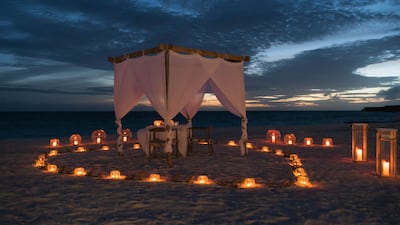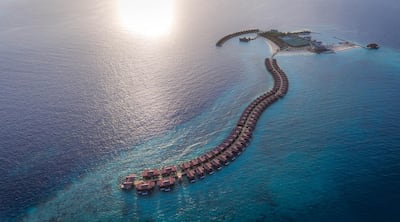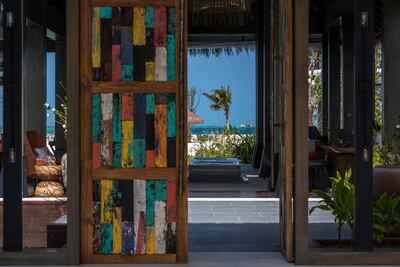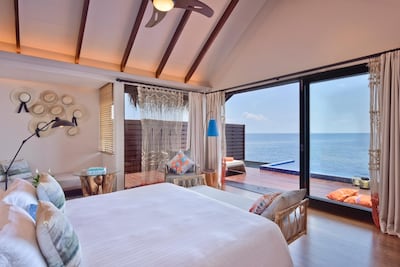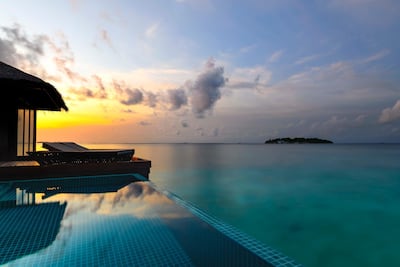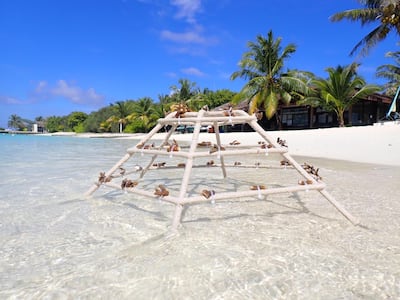Safely ensconced behind a face mask and face shield, and feeling like a second-rate Darth Vader, I navigate my way through Dubai International Airport for the first time in 11 months. What was once second nature now feels foreign – the shadow of Covid-19 falling across every surface I touch and every person I interact with.
But I am heading to the Maldives. And surely, if any place on Earth can offer respite from our current virus-ridden reality, it is the sun-drenched Indian Ocean archipelago where social distancing occurs by default and outdoor island living offers the ultimate antidote to global lockdowns and stay-home orders.
“When you have lockdown restrictions in big cities, you are dreaming about the Maldives – its tropical winds, scattered islands and villas that have a minimum seven or eight metres between them,” notes Raffaele Solferino, general manager of Grand Park Kodhipparu, my first port of call.
His claim is backed by the 75 per cent occupancy the resort is enjoying during my stay, with Indians and Russians forming the bulk of visitors. I am not alone, it seems, in perceiving the Maldives as a safe bet in a turbulent travel landscape.
The archipelago became one of the first destinations in the world to resume "normal" operations when it reopened its borders to tourists in July. All visitors must show proof of a negative PCR test, taken at least 96 hours prior to arrival, and fill in an online health declaration form. This yields an individualised bar code that must be presented upon arrival.
While the Maldives’ densely populated capital, Male, has had to contend with spikes in Covid-19 cases, movement between the capital and resort islands is severely restricted for locals and hotel staff, and international arrivals bypass it altogether – I am whisked out of the airport departure area, across a road and straight on to the Grand Park’s speed boat in a matter of minutes. Less than half an hour later, I am stepping on to the powdery sands of Kodhipparu.
The resort is small and intimate, with only 120 villas in total, and you could happily spend a whole day without engaging with another soul
There is something reassuring about being cocooned on an island during a pandemic. While Covid-19 is no respecter of geographical boundaries, there’s a sense of security that comes from being surrounded by water on all sides, with unobstructed views that roll out towards the horizon. This is particularly true at Grand Park Kodhipparu, which is set on a smidgen of land, barely 500 metres squared. The resort is small and intimate, with only 120 villas in total, and you could happily spend a whole day without engaging with another soul, should you so desire.
Oversized flamingo floats in the communal pool, a live DJ spinning house tracks in the evenings, and an Instagram-friendly swing suspended from a palm tree on a secluded stretch of beach all hint at the resort’s attempts to appeal to a younger, hipper crowd. It’s a vibe that’s built into the Grand Park’s design (conceptualised by industry stalwarts Hirsch Bedner Associates), from the jaunty tiles on the bathroom floor of my Reef Pool Water Villa, to the macrame wall hangings and neutral-toned Scandi-chic styling.
There’s a wellness slant, too, with daily yoga classes offered for free, a concerted focus on sourcing fresh, local produce where possible, and the use of 100 per cent organic Comfort Zone products in the spa.
That’s not to say you can’t indulge. At Firedoor, the resort’s fine dining restaurant, a show kitchen sits above an open stretch of water, where a visit from a pair of blacktip reef sharks adds further drama to an already stunning setting. One of the finest steaks I have ever eaten, cooked on a special Josper grill and served on a hot stone, is promptly followed by a decadent chocolate fondant.
Restaurants at the resort have all been reconfigured to ensure you never feel like you are too close to anyone else, although a sense of spaciousness is already inherent in the towering ceilings and open-to-the-elements design of each of the Grand Park's three dining outlets.
Staff all wear face masks, physical menus have been eliminated and disinfection drives are carried out on a regular basis. While guests are not obliged to wear masks when moving around the resort, they are mandatory when entering restaurants, the gift shop and other closed spaces.
Next on my itinerary is the Sheraton Full Moon Resort & Spa, which also has the advantage of being close to the airport. In this instance, the Male skyline is visible from parts of the island, although carefully disguised from certain vistas to ensure you still feel like you are far removed from the rest of civilisation.
Here, too, the Maldives’ success in convincing travellers that it is a safe haven is clear to see.
“We thought we would be lucky to have 30 per cent occupancy for December, January, February, with a decline in April and a pick-up towards the end of the year,” the resort’s general manager, Emilio Fortini, tells me. “Then all of a sudden, it just turned around. In mid December, we were full and have been ever since. So it has recovered unusually quickly, very unexpectedly, not just for the Sheraton, but for the Maldives as a destination.
“The allure of the Maldives is that you have all these open-air spaces, and everyone that comes here has to have a negative PCR test. So it feels like a safe destination relative to other places,” he adds.
Across the Maldives, PCR tests are conducted in the resorts for departing visitors, and anyone that tests positive is required to quarantine on the island for 14 days. Nonetheless, if there is a weak spot in this otherwise glowing success story, it is that the airport on our return journey is jam-packed, and more could be done to ensure social-distancing guidelines are enforced.
While hoteliers in the Maldives had braced themselves for a slow return to form, they have now been grappling with a new, unexpected set of challenges. Many resorts cut down on staff numbers at the height of the pandemic, so are operating with smaller teams, while fewer flights coming in to the Maldives means the supply of goods has been disrupted, sometimes making it difficult to source specific items.
“There was a period of two or three months where we could hardly get anything,” Fortini admits, although this is certainly not evident at the Sheraton's lavish breakfast buffet, where fresh fruit, pancakes, waffles and jars of muesli jostle for space with dosas, gluten-free muffins, servings of eggs Benedict and countless other morning treats.
The Sheraton is a resort hotel in the more typical sense – bigger, with more guests, so social distancing requires a more strategic approach. Recognising one particular bottleneck, the hotel has placed a document in rooms warning against the breakfast rush, encouraging people to go as early as possible to avoid the crowds.
The size of the resort means there is something for everyone, including five restaurants, dishing up Thai, Chinese, Caribbean, Mediterranean and international delicacies.
There are also customised dining experiences – a picnic on a secluded sand bank across from the resort’s main bay, reached by speed boat, feels gloriously decadent, while lunch in the bay, where tables are partly submerged in the sea, is the stuff Instagram dreams are made of.
There are quieter stretches of beach for those seeking privacy, and more social spaces for those who can still tolerate being anywhere near strangers. An expansive kids' club provides entertainment for the little ones, but there is also plenty to keep the adults occupied.
After a trip to the spa, I try my hand at traditional Maldivian palm frond weaving, unsuccessfully trying to create a simple braid while Hakim, our erstwhile guide, whips up an entire fedora in record time. A snorkelling trip to the nearby Kurumba reef brings me up close and personal with more blacktip reef sharks, and I take part in the resort’s coral preservation programme, attaching fragments to a customised frame in support of the resort’s efforts to preserve and propagate coral populations in the surrounding seas.
My beachfront villa looks out over a palm-tree-covered expanse leading down to the beach. On the final night of my stay in the Maldives, I sit on my patio, listening to the sound of lapping waves interspersed with the laughter of a group of guests in a nearby villa. Fittingly, given the name of the resort, a full moon hangs in the sky overhead.
And, just for a moment in time, it is possible to pretend that the world is normal again.
The BIO:
He became the first Emirati to climb Mount Everest in 2011, from the south section in Nepal
He ascended Mount Everest the next year from the more treacherous north Tibetan side
By 2015, he had completed the Explorers Grand Slam
Last year, he conquered K2, the world’s second-highest mountain located on the Pakistan-Chinese border
He carries dried camel meat, dried dates and a wheat mixture for the final summit push
His new goal is to climb 14 peaks that are more than 8,000 metres above sea level
Living in...
This article is part of a guide on where to live in the UAE. Our reporters will profile some of the country’s most desirable districts, provide an estimate of rental prices and introduce you to some of the residents who call each area home.
Abu Dhabi race card
5pm Abu Dhabi Fillies Classic Prestige | Dh110,000 | 1,400m
5.30pm Abu Dhabi Colts Classic Prestige | Dh110,000 | 1,400m
6pm Abu Dhabi Championship Listed | Dh180,000 | 1,600m
6.30pm Maiden | Dh80,000 | 1,600m
7pm Wathba Stallions Cup Handicap | Dh80,000 | 1,400m
7.30pm Handicap (TB) |Dh100,000 | 2,400m
WWE TLC results
Asuka won the SmackDown Women's title in a TLC triple threat with Becky Lynch and Charlotte Flair
Dean Ambrose won the Intercontinental title against Seth Rollins
Daniel Bryan retained the WWE World Heavyweight Championship against AJ Styles
Ronda Rousey retained the Raw Women's Championship against Nia Jax
Rey Mysterio beat Randy Orton in a chairs match
Finn Balor defeated Drew McIntyre
Natalya beat Ruby Riott in a tables match
Braun Strowman beat Baron Corbin in a TLC match
Sheamus and Cesaro retained the SmackDown Tag Titles against The Usos and New Day
R-Truth and Carmella won the Mixed Match Challenge by beating Jinder Mahal and Alicia Fox
more from Janine di Giovanni
Infiniti QX80 specs
Engine: twin-turbocharged 3.5-liter V6
Power: 450hp
Torque: 700Nm
Price: From Dh450,000, Autograph model from Dh510,000
Available: Now
Mercer, the investment consulting arm of US services company Marsh & McLennan, expects its wealth division to at least double its assets under management (AUM) in the Middle East as wealth in the region continues to grow despite economic headwinds, a company official said.
Mercer Wealth, which globally has $160 billion in AUM, plans to boost its AUM in the region to $2-$3bn in the next 2-3 years from the present $1bn, said Yasir AbuShaban, a Dubai-based principal with Mercer Wealth.
“Within the next two to three years, we are looking at reaching $2 to $3 billion as a conservative estimate and we do see an opportunity to do so,” said Mr AbuShaban.
Mercer does not directly make investments, but allocates clients’ money they have discretion to, to professional asset managers. They also provide advice to clients.
“We have buying power. We can negotiate on their (client’s) behalf with asset managers to provide them lower fees than they otherwise would have to get on their own,” he added.
Mercer Wealth’s clients include sovereign wealth funds, family offices, and insurance companies among others.
From its office in Dubai, Mercer also looks after Africa, India and Turkey, where they also see opportunity for growth.
Wealth creation in Middle East and Africa (MEA) grew 8.5 per cent to $8.1 trillion last year from $7.5tn in 2015, higher than last year’s global average of 6 per cent and the second-highest growth in a region after Asia-Pacific which grew 9.9 per cent, according to consultancy Boston Consulting Group (BCG). In the region, where wealth grew just 1.9 per cent in 2015 compared with 2014, a pickup in oil prices has helped in wealth generation.
BCG is forecasting MEA wealth will rise to $12tn by 2021, growing at an annual average of 8 per cent.
Drivers of wealth generation in the region will be split evenly between new wealth creation and growth of performance of existing assets, according to BCG.
Another general trend in the region is clients’ looking for a comprehensive approach to investing, according to Mr AbuShaban.
“Institutional investors or some of the families are seeing a slowdown in the available capital they have to invest and in that sense they are looking at optimizing the way they manage their portfolios and making sure they are not investing haphazardly and different parts of their investment are working together,” said Mr AbuShaban.
Some clients also have a higher appetite for risk, given the low interest-rate environment that does not provide enough yield for some institutional investors. These clients are keen to invest in illiquid assets, such as private equity and infrastructure.
“What we have seen is a desire for higher returns in what has been a low-return environment specifically in various fixed income or bonds,” he said.
“In this environment, we have seen a de facto increase in the risk that clients are taking in things like illiquid investments, private equity investments, infrastructure and private debt, those kind of investments were higher illiquidity results in incrementally higher returns.”
The Abu Dhabi Investment Authority, one of the largest sovereign wealth funds, said in its 2016 report that has gradually increased its exposure in direct private equity and private credit transactions, mainly in Asian markets and especially in China and India. The authority’s private equity department focused on structured equities owing to “their defensive characteristics.”
What can victims do?
Always use only regulated platforms
Stop all transactions and communication on suspicion
Save all evidence (screenshots, chat logs, transaction IDs)
Report to local authorities
Warn others to prevent further harm
Courtesy: Crystal Intelligence
What vitamins do we know are beneficial for living in the UAE
Vitamin D: Highly relevant in the UAE due to limited sun exposure; supports bone health, immunity and mood.
Vitamin B12: Important for nerve health and energy production, especially for vegetarians, vegans and individuals with absorption issues.
Iron: Useful only when deficiency or anaemia is confirmed; helps reduce fatigue and support immunity.
Omega-3 (EPA/DHA): Supports heart health and reduces inflammation, especially for those who consume little fish.
Who's who in Yemen conflict
Houthis: Iran-backed rebels who occupy Sanaa and run unrecognised government
Yemeni government: Exiled government in Aden led by eight-member Presidential Leadership Council
Southern Transitional Council: Faction in Yemeni government that seeks autonomy for the south
Habrish 'rebels': Tribal-backed forces feuding with STC over control of oil in government territory
FIXTURES
All games 6pm UAE on Sunday:
Arsenal v Watford
Burnley v Brighton
Chelsea v Wolves
Crystal Palace v Tottenham
Everton v Bournemouth
Leicester v Man United
Man City v Norwich
Newcastle v Liverpool
Southampton v Sheffield United
West Ham v Aston Villa
UAE currency: the story behind the money in your pockets
The Bio
Hometown: Bogota, Colombia
Favourite place to relax in UAE: the desert around Al Mleiha in Sharjah or the eastern mangroves in Abu Dhabi
The one book everyone should read: 100 Years of Solitude by Gabriel Garcia Marquez. It will make your mind fly
Favourite documentary: Chasing Coral by Jeff Orlowski. It's a good reality check about one of the most valued ecosystems for humanity
Virtuzone GCC Sixes
Date and venue Friday and Saturday, ICC Academy, Dubai Sports City
Time Matches start at 9am
Groups
A Blighty Ducks, Darjeeling Colts, Darjeeling Social, Dubai Wombats; B Darjeeling Veterans, Kuwait Casuals, Loose Cannons, Savannah Lions; C Awali Taverners, Darjeeling, Dromedary, Darjeeling Good Eggs
Command%20Z
%3Cp%3E%3Cstrong%3EDirector%3A%C2%A0%3C%2Fstrong%3ESteven%20Soderbergh%3C%2Fp%3E%0A%3Cp%3E%3Cstrong%3EStars%3A%C2%A0%3C%2Fstrong%3EMichael%20Cera%2C%20Liev%20Schreiber%2C%20Chloe%20Radcliffe%3C%2Fp%3E%0A%3Cp%3E%3Cstrong%3ERating%3A%3C%2Fstrong%3E%C2%A03%2F5%3C%2Fp%3E%0A
The Al Barzakh Festival takes place on Wednesday and Thursday at 7.30pm in the Red Theatre, NYUAD, Saadiyat Island. Tickets cost Dh105 for adults from platinumlist.net
Fighting with My Family
Director: Stephen Merchant
Stars: Dwayne Johnson, Nick Frost, Lena Headey, Florence Pugh, Thomas Whilley, Tori Ellen Ross, Jack Lowden, Olivia Bernstone, Elroy Powell
Four stars
More on Quran memorisation:
Dubai Creek Open in numbers
- The Dubai Creek Open is the 10th tournament on this year's Mena Tour
- It is the first of five events before the season-concluding Mena Tour Championship
- This week's field comprises 120 players, 21 of which are amateurs
- 15 previous Mena Tour winners are competing at Dubai Creek Golf and Yacht Club
Brief scores:
Day 2
England: 277 & 19-0
West Indies: 154
The%20Super%20Mario%20Bros%20Movie
%3Cp%3E%3Cstrong%3EDirectors%3A%3C%2Fstrong%3E%20Aaron%20Horvath%20and%20Michael%20Jelenic%0D%3Cbr%3E%3Cstrong%3EStars%3A%3C%2Fstrong%3E%20Chris%20Pratt%2C%20Anya%20Taylor-Joy%2C%20Charlie%20Day%2C%20Jack%20Black%2C%20Seth%20Rogen%20and%20Keegan-Michael%20Key%0D%3Cbr%3E%3Cstrong%3ERating%3A%3C%2Fstrong%3E%201%2F5%3C%2Fp%3E%0A
Past winners of the Abu Dhabi Grand Prix
2016 Lewis Hamilton (Mercedes-GP)
2015 Nico Rosberg (Mercedes-GP)
2014 Lewis Hamilton (Mercedes-GP)
2013 Sebastian Vettel (Red Bull Racing)
2012 Kimi Raikkonen (Lotus)
2011 Lewis Hamilton (McLaren)
2010 Sebastian Vettel (Red Bull Racing)
2009 Sebastian Vettel (Red Bull Racing)
Who was Alfred Nobel?
The Nobel Prize was created by wealthy Swedish chemist and entrepreneur Alfred Nobel.
- In his will he dictated that the bulk of his estate should be used to fund "prizes to those who, during the preceding year, have conferred the greatest benefit to humankind".
- Nobel is best known as the inventor of dynamite, but also wrote poetry and drama and could speak Russian, French, English and German by the age of 17. The five original prize categories reflect the interests closest to his heart.
- Nobel died in 1896 but it took until 1901, following a legal battle over his will, before the first prizes were awarded.
Everton%20Fixtures
%3Cp%3EApril%2015%20-%20Chelsea%20(A)%3Cbr%3EApril%2021%20-%20N.%20Forest%20(H)%3Cbr%3EApril%2024%20-%20Liverpool%20(H)%3Cbr%3EApril%2027%20-%20Brentford%20(H)%3Cbr%3EMay%203%20-%20Luton%20Town%20(A)%3Cbr%3EMay%2011%20-%20Sheff%20Utd%20(H)%3Cbr%3EMay%2019%20-%20Arsenal%20(A)%3C%2Fp%3E%0A




